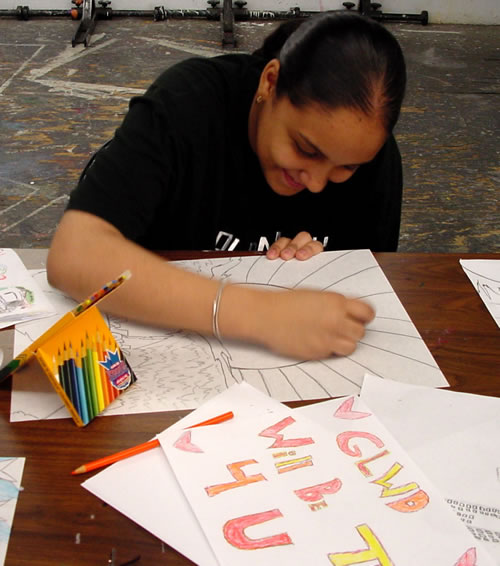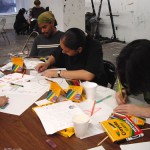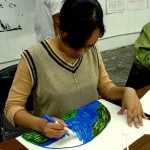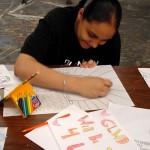
Categories
- Curriculum: Art | Community Service | Language Arts | Social Studies
- Age/Grade: Elementary 3 | Middle School | Above 14
- Subject: Drawing | Writing | Painting | Exhibition
- Materials: Mixed Media | Pencils | Markers
- Institution: School of Visual Arts
- Location: New York, New York
- Duration: 5 Classes
Description
This insightful lesson combines ethics with art, allowing students to consider the social and political climate they live in, and to take positive action by creating posters that inspire awareness and change.
Objective
Students will gain a familiarity with Keith Haring's artwork as well as his interest in helping people and the causes he believed in.
Students will expand their vocabulary: Elements of design, principles of design, line, repetition, shape, rhythm, contrast, balance, unity, complementary color, analogous color, charities, philanthropy, volunteering, symbols...
Students will develop their ability to observe, describe, and interpret works of art.
Students will gain experience in contemplating various (and sometimes conflicting) data and weighing perception, facts, and opinions in order to make informed judgments.
Students will cultivate deductive reasoning skills by practicing to gather clues, building evidence, and framing formed conclusions.
Students will express their objective responses to artworks involving reasoning yet remain open ended.
Students will learn to articulate their ideas and opinions while also learning to listen and respond to others.
Students will compose an image using elements and principles of design.
Students will strengthen their ability to make artistic choices that communicate a specific idea.
Students will realize that varying opinions about art can be discussed and debated.
Students will experience that art can be used to help people.
Students will learn that posters can be a way to publicly communicate a specific meaning addressing a wide audience.
Resources
Keith Haring's posters for charities
Posters with a Message (another Haring-inspired lesson!)
Posters, a lesson
Sussman, Elizabeth. Keith Haring (Whitney Catalogue- OUT OF PRINT)
For Haring Exhibition catalogs- Call Pop Shop at 212.219.2784 to get a list of catalogs.
Designer Posters. Rockport Publishers, Inc. 1996. (ASIN: 1564962474)
Materials
11" x 17" Paper
Pencils
Color pencils
Colored markers
Glue
Colored paper
Scissors
Procedure
MOTIVATION
Show posters that Keith Haring made. Student will learn about how generous Keith was and the causes he believed in. Engage in a discussion of issues that are affecting students. It could be motivated by current events, social, political, media related, etc.
QUESTIONS
What are some worth while causes that you know of?
What are some issues or concerns that you face today?
What are some ways to help people?
What are some organizations or charities that you know of?
What does volunteering mean?
Who here has every help anyone? Volunteered?
How does the image convey the message?
How might the design be improved?
What are the main colors used in the poster?
What symbols (if any) are used in the poster?
Who do you think is the intended audience for the poster?
What does the artist that deigned the poster hope the viewer will do?
What purpose is served by the poster?
What are the similarities and differences between the posters?
Where do you think these posters were hung?
What emotions do these posters prompt?
What is the message of each?
Talk about the colors used in the background, images and text; letters, pictures, and message.
Does the poster have too much text and images in it? How? Is it confusing?
How effective is the poster in getting its message across?
How might you change the poster?
PROCEDURE
Setting up before class: (10 mins)
1. Put up posters by Keith Haring as well as other posters.
2. Take out all the materials needed for the brainstorming session, game, and demonstration. (books, 8x10 paper, markers, pencils, rulers, list of words for the game, and list of slogans).
Class time:
Introduction and discussion
1. Show examples of posters and using the questions above engage the class in a group discussion about them. Talk about the content and issues addressed in the posters.
2. Use the issues that Keith Haring addressed in his posters as a way to lead into a discussion of issues that are affecting students. It could be motivated by current events, social, political, media related, etc. Talk about problems that are related to the issues, causes of the problems, effects of the problems on people and possible solutions to the problems. Write down some of the topics discussed. Some examples are:
Current Events
War on Terrorism, September 11th
War on Iraq
SARS
Environmental issues
Rainforest preservation
Animal rights
Political prisoners
Human rights
Racism
Violence
AIDS
3. Talk about charities and ways of helping to resolve or advocate for these issues. Talk about God's Love We Deliver and their mission.
Brainstorming PART 1
1. Have students brainstorm a list of words about the organization.
2. From the list of words have the students brainstorm other words.
3. Now using those words have the students break up into groups and come up with as many different slogans using the words. The slogan cant be more than 5 words. The group with the most slogans win. But if two groups come up with the same slogan then it cancels out and is not counted.
Pictionary
Play a custom made version of Pictionary. Create the words that relate to the project . Break class up into groups. Have one person from each group come up and inform them of the chosen word. The rest of the group has to guess what the word is only by images that is drawn. No words are allowed to be used.
*After the game look back at the drawings and discuss them as a class.
Brainstorming PART 2
Have students brainstorm various images that could be used to represent the organization. Talk about the images. For example: delivering food. What are the different ways of delivering food. What do you use to deliver food? What types of foods can be delivered. Who delivers food? Describe the person. How did the drawings relate to the words? What are other images that can be used to represent the word?
Demonstration
1. Tell students to gather the students into a group.
2. Model the making of a poster with students.
3. Use one of the slogans that the students came up with as an example. Discuss the importance of a slogan. Talk about placement, size, and font. Use a ruler to draw the top and bottom guiding lines, and clearly and neatly write the slogan.. Maybe the slogan can be incorporated into the image so that it's not just horizontal. Curve in a circle? Wavy?
4. Have the students come up with an image that relates to the slogan. A few students can draw onto the demonstration poster. Talk about elements and principles of design. (Line, shape, direction, size, texture, color, balance, contrast, repetition). Stress the fact that these posters will be seen by people so how do you get the message across to people that don't know anything about the charity? The most effective posters use symbols that are unusual, simple, and direct. The image alone has to be able to get the message across. What if the viewer didn't know English or Spanish? How can you communicate with just the image?
5. Besides drawing tell the students that they have the option of creating their images with collage. But stress the fact that the students that want to use this technique still have to sketch out their idea first. Cut out the images and words using paper. Arrange the cut outs before you glue anything down. Don't give out the glue until the students have all their images arranged the way they want.
Students work on the project
1. Hand out materials.
2. Make your way around the classroom to help students get started.
3. (Project will take at least 2 or 3 classes) Each class, have a class critique of the posters. Have the students talk about their posters. Incorporate the discussion questions into the critiques.
SUMMARY
As a class the students will talk about their final poster and how it communicates the meaning. We can talk about other ways of helping a charity, for example, volunteering at a charity. Take a field trip and visit the charity that the students created posters for.
Extensions
NYS ARTS STANDARDS EMPLOYED
1. Creating, Performing and participating in the arts. Students will create posters using elements and principles of design.. Knowing and Using Arts Resources and Materials. Students will be familiar with making a poster by drawing and collage techniques.
3. Responding and Analyzing Works of Art. Students will actively engage in a class discussion by observing, describing and interpreting artworks by Keith Haring.
The author of this lesson, Wan Ling Li, a student of the School of Visual Arts in NYC, is the 2002-2003 scholarship recipient of the Keith Haring Scholarship award. This project was a collaboration with The School of Visual Arts & The Liberty Partnership Program* in New York City.
To find out more about The Keith Haring Foundation Scholarship offered through the School of Visual Arts, please contact:
Director, School of Visual Arts/Visual Arts Foundation, 15 Gramercy Park South, NYC 10003.
*The Liberty Partnership Program (LPP) is for students enrolled in 5th through 12th grades. LPP targets students who have been identified as being at-risk for dropping out of school because of poor academic performance, truancy, discipline, family circumstances, negative peer pressure and other documented factors.



